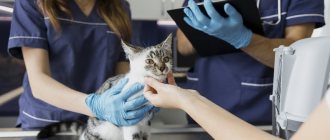Victoria Rashidovna Khazimulina
veterinarian Petstory
Mycoplasmosis in cats is an infectious disease, most often asymptomatic, but under certain conditions it affects the respiratory, urinary, reproductive, musculoskeletal systems and eyes. The causative agents of mycoplasmosis are gram-negative bacteria that do not have a cell membrane. They invade mucosal epithelial cells and destroy them. However, mycoplasmas are often found in clinically healthy animals, which indicates their opportunistic nature. Will the detection of these bacteria always mean that the animal needs treatment? Let's look at this question below.
Mycoplasmosis in cats: the main thing
- Mycoplasmas are a group of gram-negative microbes that are not always dangerous for cats.
- The cause of the development of mycoplasmosis in cats, as a rule, is a concomitant infection, damage to the mucous membranes or a disorder of the immune response.
- Infection occurs through contact with an infected animal.
- The most common symptoms are redness of the mucous membranes, discharge from the eyes and nose, coughing, sneezing, and fever. However, there may be other abnormalities, depending on the location of the infection (lameness, pain when urinating, discharge from the loop, etc.).
- Diagnosis consists of a thorough history taking, examination, and mycoplasmosis is finally confirmed by PCR or bacteriological culture.
- Treatment depends on the severity of symptoms and associated pathologies. As a rule, antibiotics are used locally and systemically. But the drug must be prescribed by a doctor, since not every antibiotic acts on these microorganisms.
- The main preventive measure is a healthy lifestyle (timely vaccination, proper diet, personal hygiene).
- Feline mycoplasmosis is not dangerous to humans. However, you should follow the rules of personal hygiene (wash your hands, do not kiss your pet, etc.).
Treatment
Since the most characteristic manifestations of mycoplasmosis in cats are conjunctivitis and rhinitis (inflammation of the outer membrane of the eye and the mucous membrane of the nasal cavity), symptomatic treatment will be aimed at eliminating them. Prescribed washing of the mucous membranes with saline solutions, as well as local antibacterial and anti-inflammatory therapy: eye drops Tsiprolet, Dekta-2, Lacrimin aseptic, Iris, Conjunctivitin, nasal preparations Argumistin, Fosprenil.
To destroy the causative agent of the disease, antibiotics of the tetracycline group, Doxycycline or Levomycetin, which suppress the synthesis of prokaryotes, are most often used. The standard duration of treatment is from 7 to 14 days.
Also used:
- aminoglycosides Gentamicin, Netilmicin, Amikacin;
- fluoroquinolones Ofloxacin, Levofloxacin;
- macrolides Azithromycin, Zithrocin, Clarithromycin, Tylosin.
After a course of antibiotics to restore liver and intestinal function, animals are usually prescribed maintenance therapy. These are hepatoprotectors Divopride, Hepatovet, Vet Expert Hepatiale Forte and probiotic preparations containing beneficial bacteria for the gastrointestinal tract FortiFlora, Pro-Kolin Protexin, Aminosu, Yoguru, Zendakim.
When treating cats for mycoplasmosis, immunostimulants (bioactive substances that activate the immune system) are mandatory: Gamaprene, Immunol, Vet Forvet, Salmozan.
Causes of the disease
As we said earlier, mycoplasma is often detected in tests in clinically healthy cats. The fact is that a healthy body is quite capable of protecting itself from this bacterium.
Most often, mycoplasmosis in cats develops due to a violation of the barrier function of the mucous membranes.
Thus, the cause of the disease may be:
- Complications of other diseases (asthma, herpesvirus, calicivirus, chlamydia, bordetellosis, etc.);
- Decreased immunity (viral immunodeficiency, taking immunosuppressants);
- Violation of the barrier function of mucous membranes (allergies, hypothermia, stress);
- Entering the body of a large amount of the pathogen - for example, through close contact with an infected animal.
What causes danger
- Toxicity
The waste products of mycoplasmas are dangerous due to their toxicity and destructive effect on the cells of the body. Because of this, the normal functioning of all important organs becomes impossible: eyes, gastrointestinal tract, respiratory organs and genitourinary system.
- Provoking infections
A healthy human or animal body always (!) contains within itself various pathogenic bacteria in a “dormant state,” and mycoplasmas have the ability to “awaken” them to active life, thereby provoking various infectious diseases. And the weaker the immune system, the greater the chances of getting sick.
Mycoplasmas are provocateurs!
Symptoms
Symptoms of mycoplasmosis in cats depend on the location of the disease. Mycoplasma can affect the eyes, respiratory, urinary, reproductive systems and even joints.
Therefore, the symptoms of this disease are very varied:
- Copious nasal discharge, sneezing, nasal congestion;
- Cough;
- Pain when swallowing;
- Excessive discharge from the eyes, redness of the conjunctiva, clouding of the eyes;
- Fever;
- Rapid breathing (tachypnea);
- Increased breath sounds;
- Frequent and painful urination, blood in the urine;
- Swelling of the joints, lameness;
- A sign of cystitis is frequent, painful urination;
- Signs of inflammation of the uterus - vaginal discharge, pain in the abdominal wall.
Prescription regimen for macrolides in the treatment of mycoplasmosis
- midecamycin (macropen) - 500 mg 3 times. per day for 1 - 2 weeks;
- erythromycin (eryfluid, erythrin, eracin) - 500 mg 4 times. per day for 1 - 2 weeks;
- clarithromycin (fromilid, clubax, clarithrosin) - 250 mg 2 times a day. per day for 1 - 2 weeks, for the prolonged form (clacid CP) - 500 mg 1 r. per day for 1 - 2 weeks;
- josamycin (vilprafen) - 500 mg 3 times. per day for 1 - 2 weeks;
- azithromycin (azithral, chemomycin, sumamecin, azivok, sumamed zy-factor) - 250 mg 1 r. per day for 6 days or 1 g as a single dose.
Midecamycin and josamycin are characterized by the absence of side effects and good tolerability.
Azithromycin and clarithromycin, unlike erythromycin, have a high ability to penetrate into cells and high stability in an acidic environment.
Macrolides belonging to the first generation - midecamycin, erythomycin and josamycin - can be prescribed even during the first trimester of pregnancy. Second generation macrolides - roxithromycin, clarithromycin, azithromycin - are contraindicated during pregnancy.
Absolutely all types of mycoplasmas are highly sensitive to antibiotics belonging to the fluoroquinolone group. In this case, preference should be given to ofloxacin - it has good pharmacokinetic characteristics and high bactericidal activity.
Ofloxacin (taricin, zanocin, tarifferid, tarivid, oflomac) take 600 mg 1 r. per day for 7 - 10 days. It seems rational to prescribe ofloxacin in cases where gonococcal and ureaplasma infections are combined.
Mokifloxacin (Avelox) is taken 400 mg 1 r. per day for 10 days.
Drugs of this group of antibiotics, as well as tetracyclines, are undesirable for use during pregnancy.
Lincosamines have no effect on ureaplasma.
Of the aminoglycosides, gentamicin (gentacycol, geramicin) is used. It is prescribed 40 mg 3 times. per day for 5 days.
Determination of antibiotic sensitivity in the treatment of mycoplasmas
In recent years, the percentage of mycoplasma strains that are resistant to various groups of antibiotics has been steadily increasing. In addition, resistance may differ within groups. This necessitates the determination in laboratory conditions of the antibiotic sensitivity of urogenital mycoplasma strains in relation to a wide range of potentially active antibiotics.
A study was conducted at the Irkutsk Medical University in 2007, during which the resistance and susceptibility of urogenital mycoplasmas to eight antibiotics included in the Mycoplasma IST 2 test system was studied, using the example of 65 cultures of M. hominis and 153 cultures of U. urealyticum , which were isolated from patients with ureamycoplasma infection.
Based on the results obtained from the study, a corresponding conclusion was made: urogenital mycoplasmas are highly sensitive to josamycin, tetracycline and doxycycline. The lowest sensitivity is observed to erythromycin and ciprofloxacin.
A wide range of drugs for determining antibiotic sensitivity for mycoplasmosis and ureaplasmosis is produced by the Department of New Technologies of the St. Petersburg Research Institute of Epidemiology and Microbiology named after Pasteur. For several types of mycoplasmas - Ureaplasma urealyticum and Mycoplasma hominis - test systems are offered that determine sensitivity to 4 antibiotics (pregnant kit), 6 antibiotics (basic set) and 12 antibiotics (extended set).
Diagnostics
The diagnosis of mycoplasmosis is made based on symptoms and laboratory tests. Samples from affected organs are used for research. In this case, it is important that the smear is taken directly from the walls of the mucous membranes, using a special probe, capturing epithelial cells. This is necessary because the pathogen multiplies in epithelial cells and to confirm the diagnosis it is necessary to detect it there, and not on the surface in secretions, where mycoplasma can also be found in healthy animals.
The samples taken are sent to the laboratory in a special tube with a transport medium for examination by PCR or bacteriological culture.
Is it contagious?
...for a person?
There is only one answer to this question: feline mycoplasmosis is not transmitted to humans.
Research by various scientists has proven the existence of about 100 species of mycoplasmas. Of these, only 6 are dangerous to humans. They are transmitted from an infected person to a healthy person through sexual contact. And the child becomes infected from the mother in utero or at birth.
…for cats?
Feline mycoplasmas are harmless to the strong immunity of healthy animals. It protects them from infection!
Is it dangerous for pets who are weakened, pregnant, young or over 8 years old?
Answer: dangerous and contagious!
Infected and sick animals are a source of infection for this risk group.
…for dogs?
Dogs and cats have different types of mycoplasma that causes the disease. Therefore, the possibility of them becoming infected from each other is unlikely.
Prevention of mycoplasmosis
There is no vaccine against mycoplasmosis, so prevention comes down to taking precautions, timely vaccination against other diseases, regular treatment for parasites, and a balanced diet.
Vaccination should be done against infections that may be complicated by mycoplasmosis (herpesvirus, calicivirus, chlamydia). Avoid stress and hypothermia. Do not let your pet out onto the street or balcony in cold weather, after bathing, avoid drafts, and if necessary, carefully insulate the carrier when transporting it.
Do not allow your pet to come into contact with potentially sick animals. If you have a new pet, you need to keep it in quarantine (in a separate room) for 14 days. If symptoms of the disease appear, you should consult a doctor and begin treatment, and after contact with a sick pet, thoroughly sterilize your hands and care items before contacting other cats.
Errors in the diet can provoke the development of conjunctivitis, rhinitis against the background of allergies, which will affect the growth of the mycoplasma colony. In addition, a lack of certain nutrients can negatively affect a pet’s immunity, so proper feeding is perhaps one of the most important aspects of preventing any disease.
How can your pets become infected?
In several ways:
- from a sick animal or from a carrier of infection;
- through toys, combs, food bowls, bedding for a sick purr;
- during mating;
- through mosquito bites;
- through fleas, ticks, lice eaters;
- from the mother at birth and breastfeeding;
References
- Plakhova, K.I. Clinical significance of genetic variability of genital mycoplasmas. – Bulletin of Dermatology and Venereology, 2015. – No. 2. — P.76-83.
- Savicheva A.M., Shpitsina, E.V. Genital mycoplasmas. - Doctor, 2009. - No. 1. — P.9-12.
- Federal clinical guidelines for the management of patients with urogenital diseases caused by Ureaplasma spp., Mycoplasma Hominis; Moscow, 2015. - 24 p.
- Dessi, D., Margarita, V., Cocco, A. et al. Trichomonas vaginalis and Mycoplasma hominis: new tales of two old friends. - Parasitology, 2021. - Vol. 146(9). — P. 1150-1155.











